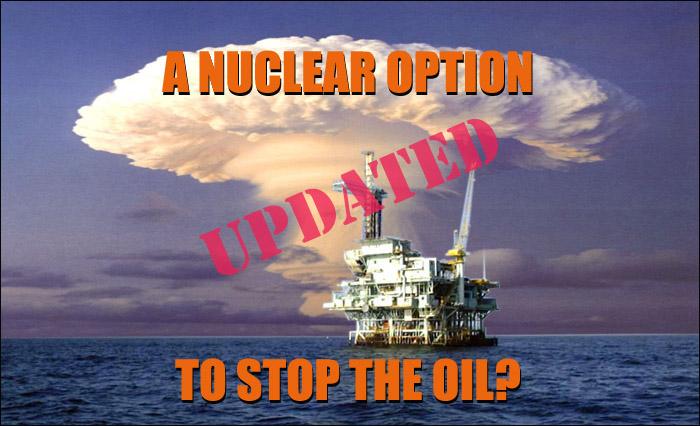
The Nuclear Option: It may happen
By Gary Vey
It's so surreal... like a sci-fi movie. The earth is threatened by a huge hole in its crust, leaking crude oil like a highly pressurized volcano and threatening to kill all life in the oceans. The solution? The military detonate a nuclear bomb in an attempt to melt the cap rock and seal the leak.
But this is no science fiction. As reported on May 14th, Barack Obama sends nuclear experts to tackle BP's Gulf of Mexico oil leak:
The US has sent a team of nuclear physicists to help BP plug the "catastrophic" flow of oil into the Gulf of Mexico from its leaking Deepwater Horizon well, as the Obama administration becomes frustrated with the oil giant's inability to control the situation.Barack Obama has sent five nuclear experts to tackle BP's Gulf of Mexico oil leak. Mr Obama, standing with Interior Secretary Ken Salazar, center, and Homeland Security Secretary Janet Napolitano, left, delivers remarks in the Rose Garden of the White House in Washington following his closed meeting with his Cabinet and other senior administration officials on the ongoing effort to stop the BP oil spill. The five-man team -- which includes a man who helped develop the first hydrogen bomb in the 1950s -- is the brainchild of Steven Chu, President Obama's Energy Secretary.
He has charged the men with finding solutions to stop the flow of oil.
How will this real sci-fi event end? Well, expers are saying that the leak will either be stopped by the extreme heat from a nuclear blast fusing the rocks surrounding the deep pipe -- or -- as one expert put it, "we could end up with a hole a quarter mile wide spewing oil... another possible scenario is a sea floor collapse. If that happens Katie bar the door."
What you have not been told
The well that BP had just about finished before it exploded was what is called a "deep oil" well. While it is true that the floating oil rig was almost a mile above the drill head, the oil that they tapped was yet another 30,000 feet (over 5 miles) under the ocean floor. Yes, that's aptly named "deep oil"! The deposit of oil they were tapping in to has been described as the second largest oil deposit ever -- anywhere -- even when one considers Saudi Arabia, the Russian discoveries, Iraq. This oil deposit has been estimated to have the potential to yield 500,000 barrels of oil per day for from 10 to 15 years!
The well that exploded and sank was cautiously tapping the fringe of the deposit after discovering that the central pressure of the oil and natural gas was as high as 165,000 to 170,000 psi. For comparison, your SUV tires usually contain 40 psi. The weight of a mile of ocean water plus 5 to 6 miles of caprock create enormous pressures on the pocket of hydrocarbons making it like a balloon ready to explode -- as it did when a small bubble of methane shot up the pipe and destroyed the oil rig.
According to insiders, the deposit is mostly natural gas -- a ratio of 10,000 to 1 -- with oil being a small portion of the bounty. It covers an estimated 25,000 square miles, extending from the inlands of Alabama, Florida, Louisiana and Texas. It's huge and, like a plump blister, it's ready to pop.
The pipe seen in the video [above] is 53 centimeters wide, (about 20 inches.)
The leak itself was originally estimated to be 1,000, then 5,000 and now 70,000 barrels of crude oil per day. The most recent estimates followed a review of video, taken of one of the leaking pipes from a deep submersible [Dr. Steve Wereley, Professor at Perdue University 1]. There are actually three leaks in all.
Ian MacDonald, a biological oceanographer at Florida State University, has compiled data showing that as much as 1 million gallons of oil a day may be flowing from the well. As of May 7 -- more than a week ago -- MacDonald estimated that 13 million gallons had been spilled in the Gulf, according to FSU. By comparison, the 1989 Exxon Valdez spill in Alaska is estimated at 11 million gallons.
MacDonald used U.S. Coast Guard aerial overflight maps of the oil to estimate its surface area, "then applied standard guidelines to measure the thickness of the oil itself," the university said in a statement. "By combining the two, he was able to provide a revised estimate showing that the oil spill is far worse than originally believed."
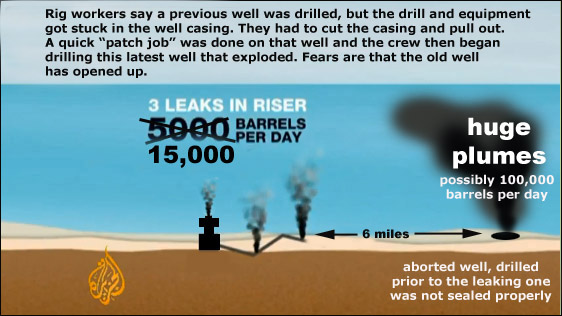
When the methane shot up the pipe to the oil rig, the rig exploded and sank. As it sank it fell to one side of the well head, taking the connecting pipe with it. The pipe bent like a straw and formed kinks as it followed the sinking rig. Although the leaks are in the straight sections of the pipe, the kinks caused structural weakness and it is worried that they could be the site of future leaks.
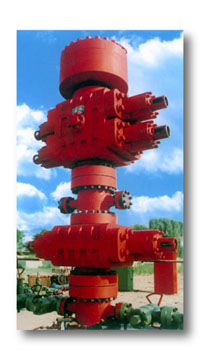 This catastrophic event was foreseen. The oil industry has been drilling for about 50 years and the loss or damage to the pipes is a worse case scenario that is supposed to be protected by shut-off valves (called "blow out protectors" [right) located in a special housing at the well head. At the first sign of damage, a special acoustic (sound) signal can be sent to listening devices located on the housing which then activates the valves to close. Apparently this was not functioning and the valves either partially or totally failed to close.
This catastrophic event was foreseen. The oil industry has been drilling for about 50 years and the loss or damage to the pipes is a worse case scenario that is supposed to be protected by shut-off valves (called "blow out protectors" [right) located in a special housing at the well head. At the first sign of damage, a special acoustic (sound) signal can be sent to listening devices located on the housing which then activates the valves to close. Apparently this was not functioning and the valves either partially or totally failed to close.
Changes in the oil since the leak
Experts are concerned that the oil leak has changed, exhibiting a combination of natural gas, crude oil and (most worrying) rock particles. They theorize that the sudden release of the hydrocarbons from the deposit are taking some of the cap stone with it, eating away at the very structure that has naturally contained the deposit for aeons. Eventually this scouring of the rock could result in a collapse of the capstone and a catastrophic release of the pressurized gas and oil. But with 5 miles of stone to eat, this scouring could be some time to come.
More worrisome is the abrasive effect that this could be having on the inside of the pipe itself. The pressurized rock is in effect a huge sand-blaster that can easily weaken it and create new holes -- especially right at the well head itself.
Two huge plumes were discovered on May 16 under the ocean which show that the oil, as measured from the surface and underwater video of the pipe, may not be all that BP has to cope with.
The pictures [above] show oil gushing from the well head's failed blow-out valve. BP doesn't talk too much about the other leaks and the underwater plumes that they are creating -- instead it keeps focus on the one that it has plugged with a small suction tube, even though this tube is only siphoning off an estimated 2% of the leaking oil and natural gas. The other leaks are responsible for huge plumes which originate in other sections of pipe and at the well head, as seen in this photo.
The plume is one of a number that scientists have found gushing into the sea a mile underwater, increasing concerns that the size of the spill could be thousands of times larger than has been previously calculated, according to The New York Times.
"There's a shocking amount of oil in the deep water, relative to what you see in the surface water. There's a tremendous amount of oil in multiple layers, three or four or five layers deep in the water column." -- Samantha Joye, from the University of Georgia, who is involved in one of the first scientific missions to gather information from the spill.
After studying footage of the gushing oil, scientists on board the research vessel Pelican, which is gathering samples and information about the spill, said that it could be flowing at a rate of 25,000 to 80,000 barrels of oil a day, or 3.4 million gallons a day!
The underwater plumes and the surface slicks have already entered the "loop" current which is expected to transport the oil around the southern tip of Florida and on up the East Coast.
Is the nuke option for real?
Unfortunately, it is. And it would not be the first time this was done.
Back in 1963, a poorly drilled natural gas well in the Soviet Union exploded and caught fire. The result was what was described as a blow torch about 120 meters high that had the sound of 100 jets and was so hot that it was almost impossible to approach. It continued to blow for three years and showed no signs of slowing. The flow was calculted at 12-million cubic centimeters of gas per day! Soviet scientists eventually drilled towards the area of the leak at an angle and inserted a nuclear bomb which detonated and fused the leak. (Images of the above gas leak have been censored and are hard to find.)
While that leak was successfully capped, others, like the one in Turkmenistan, called "The Door in Hell" have not been stopped and continue to burn after almost 40 years [below]. Billions of cubic cenimeters of natural gas have been burned up and countless tons of CO2 have been put in the atmosphere. It was decided that either every possible solution was already tried, and failed, or that other solutions were far too dangerous and might make the situation worse.
The Soviet natural gas well was very different from the oil leak in the Gulf of Mexico. It was located in the middle of a desert with sparse flora, fauna or human life to deal with the resulting radiation. The BP well, on the other hand, is just 100 miles off the shore of Louisiana and lies right in the midst of the most productive fishing and oceanic ecosystems. Winds routinely blow on shore from the location of the oil leak. Weighing the risks to the environment plus the possibilities of making the catastrophe even worse against a continuation of the oil leak that may do the same damage if left unchecked... is quite a difficult decision to make.
In sci-fi movies the ending is almost always happy. Will this be?
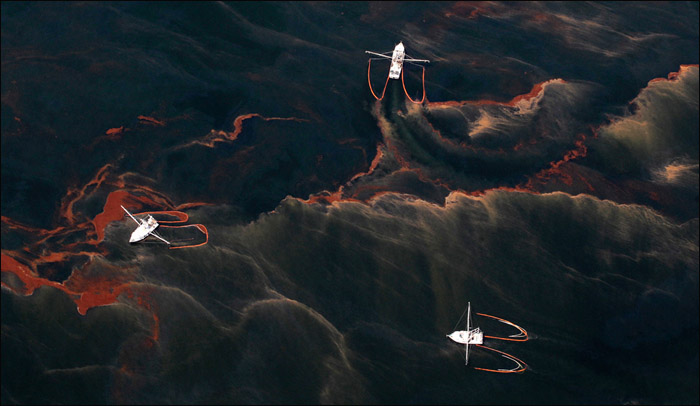
Right now the approach being used to solve this dilemma is, at best, lame. Small fishing boats are sent out to scoop up tiny acre size patches of floating crude [above] while, as seen from above, hundreds of square miles have already been sullied with deadly, red paste. Oceanographers tell us that it doesn't take much oil to kill life in the oceans. Since so much of the life cycles in the water depend on oxygenating at the surface, covering the water with an impenetrable layer rapidly kills organisms that require air. And it doesn't take much oil to do this -- even a thin slick can be deadly.
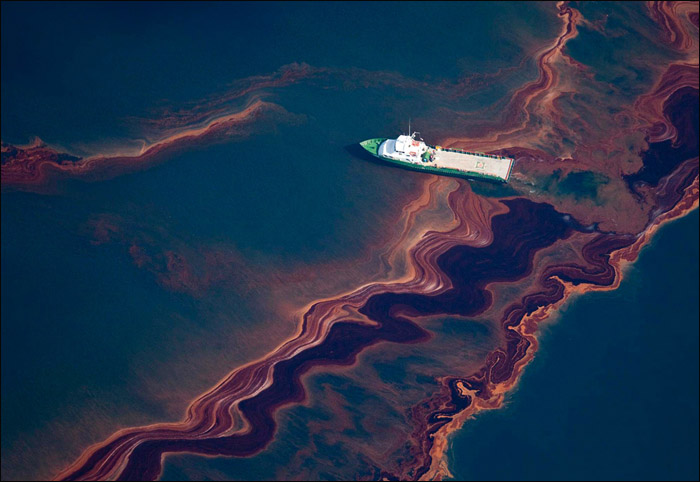
But the oil does even more damage as it settles on the ocean floor. Shrimp, lobsters and shellfish make their habitat on the ocean bottom. Once the oil get down there it's almost impossible to clean up. This is not only a death sentence for marine organisms but for the entire Gulf coast economy, who rely on fishing and tourism for their survival. One can only imagine that, if a nuclear option was used to seal the oil leak, would anyone feel safe eating fish or shrimp from those same waters? Would anyone want to swim or vacation near there?
If you think these ideas are not seriously being considered -- think again. CBS News, The Christian Science Monitor and other news sources have been boldly exploring this solution in editorials.
What do YOU think?
UPDATE: May 15, 2010 -- The latest attempt is to insert a tube in the end of the bent pipe [below], vacuuming out the oil before it has a chance to enter the ocean. Although BP officials admit it will not be 100% effective, they appear optimistic that it will improve the situation.
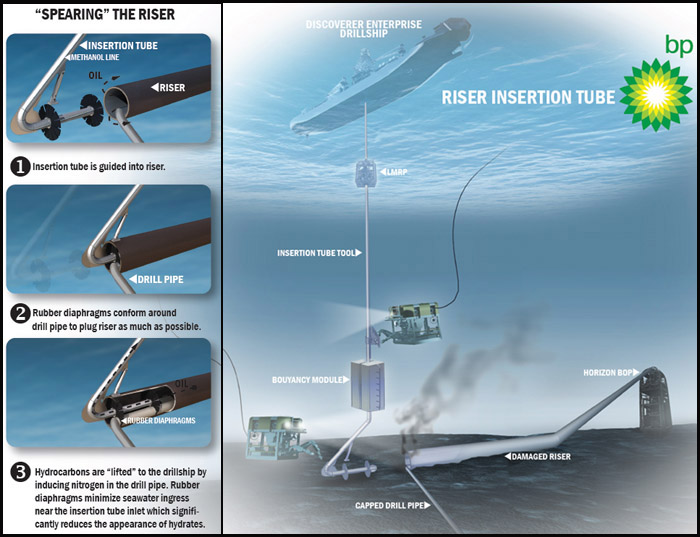



























 An election for President and Commander in Chief of the Military must strive to be above reproach. Our public institutions must give the public confidence that a presidential candidate has complied with the election process that is prescribed by our Constitution and laws. It is only after a presidential candidate satisfies the rules of such a process that he/she can expect members of the public, regardless of their party affiliations, to give him/her the respect that the Office of President so much deserves.
An election for President and Commander in Chief of the Military must strive to be above reproach. Our public institutions must give the public confidence that a presidential candidate has complied with the election process that is prescribed by our Constitution and laws. It is only after a presidential candidate satisfies the rules of such a process that he/she can expect members of the public, regardless of their party affiliations, to give him/her the respect that the Office of President so much deserves.

No comments:
Post a Comment
Note: Only a member of this blog may post a comment.